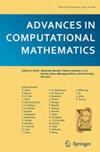Numerical simulation of resistance furnaces by using distributed and lumped models
IF 1.7
3区 数学
Q2 MATHEMATICS, APPLIED
引用次数: 0
Abstract
This work proposes a methodology that combines distributed and lumped models to simulate the current distribution within an indirect heat resistance furnace and, in particular, to calculate the current to be supplied for achieving a desired power output. The distributed model is a time-harmonic eddy current problem, which is solved numerically using the finite element method. The lumped model relies on calculating a reduced impedance associated with an equivalent circuit model. Numerical simulations and plant measurements demonstrate the effectiveness of this approach. The good correlation between the results indicates that this approximation is well-suited to support the design and improve the efficiency of the furnace in a short time.
利用分布式和集合式模型对电阻炉进行数值模拟
这项研究提出了一种方法,将分布式模型和叠加式模型相结合,模拟间接电阻炉内的电流分布,特别是计算为达到所需的功率输出而需要提供的电流。分布式模型是一个时谐涡流问题,采用有限元法进行数值求解。叠加模型依赖于计算与等效电路模型相关的减小阻抗。数值模拟和工厂测量证明了这种方法的有效性。结果之间的良好相关性表明,这种近似方法非常适合支持设计,并能在短时间内提高熔炉的效率。
本文章由计算机程序翻译,如有差异,请以英文原文为准。
求助全文
约1分钟内获得全文
求助全文
来源期刊
CiteScore
3.00
自引率
5.90%
发文量
68
审稿时长
3 months
期刊介绍:
Advances in Computational Mathematics publishes high quality, accessible and original articles at the forefront of computational and applied mathematics, with a clear potential for impact across the sciences. The journal emphasizes three core areas: approximation theory and computational geometry; numerical analysis, modelling and simulation; imaging, signal processing and data analysis.
This journal welcomes papers that are accessible to a broad audience in the mathematical sciences and that show either an advance in computational methodology or a novel scientific application area, or both. Methods papers should rely on rigorous analysis and/or convincing numerical studies.

 求助内容:
求助内容: 应助结果提醒方式:
应助结果提醒方式:


